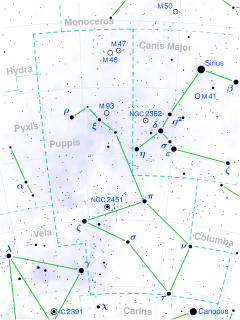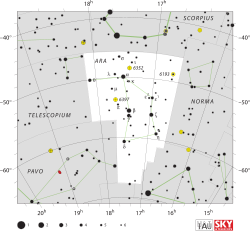
Rho Scorpii is a double star in the constellation of Scorpius. It has an apparent visual magnitude of +3.87, which is bright enough to be seen with the naked eye. Based upon parallax measurements, it is located approximately 472 light years from the Sun. At that distance, the visual magnitude of the system is reduced by 0.07 due to extinction from interstellar dust. It is a member of the Upper Scorpius OB association.

Iota1 Scorpii, Latinized from ι1 Scorpii, is star in the southern constellation of Scorpius. With an apparent visual magnitude of 3.03, this star can be seen with the naked eye. It is sometimes called by the proper name Apollyon. Parallax measurements place it at a distance of roughly 1,930 light-years from Earth, with a 9% margin of error.
Rho Telescopii is the Bayer designation for an astrometric binary star system in the southern constellation of Telescopium. It is visible to the naked eye, with an apparent visual magnitude of +5.17. Based upon an annual parallax shift of 17.63 mas as measured from Earth, it is located approximately 185 light years from the Sun.

Epsilon Apodis, Latinized from ε Apodis, is the Bayer designation for a star in the southern circumpolar constellation of Apus. It has an apparent visual magnitude of 5.06, which is bright enough to be viewed from dark suburban skies. Based upon parallax measurements, it is at a distance of roughly 640 light-years from Earth.

Rho Aquarii, Latinized from ρ Aquarii, is the Bayer designation for a binary star system in the equatorial constellation of Aquarius. It is visible to the naked eye with an apparent visual magnitude of +5.34. Based upon parallax measurements, this star is at a distance of roughly 870 light-years from Earth. It is drifting closer with a radial velocity of –9 km/s. The proximity of this star to the ecliptic means it is subject to lunar occultations.

Theta Arae, Latinized from θ Arae, is the Bayer designation for a star in the constellation Ara. It has an apparent visual magnitude of +3.67, which is bright enough to be seen with the naked eye. Based upon an annual parallax shift of 4.01 mas, Theta Arae is 810 light-years distant from the Earth.

Iota Arae, Latinized from ι Arae, is the Bayer designation for a star in the southern constellation of Ara. It is approximately 930 light-years from Earth, give or take a 70 light-year margin of error, and has an apparent visual magnitude of 5.25. Based upon the Bortle Dark-Sky Scale, this means the star is visible to the naked eye from suburban skies.

V539 Arae (Bayer designation Nu1 Arae (ν1 Arae / ν1 Ara)) is a triple star system in the southern constellation of Ara. Based upon an annual parallax shift of 3.30 ± 0.47, this system is at a distance of roughly 1,000 light-years (310 parsecs) from Earth.
Sigma Centauri, Latinized from σ Centauri, is the Bayer designation for a solitary star in the southern constellation of Centaurus. It is visible to the naked eye with an apparent visual magnitude of 3.91. A visual companion at an angular separation of 88.11±0.37 mas along a position angle of 14.33°±2.59° was detected in 2010 using interferometry, but its association with Sigma Centauri remains undetermined as of 2013. The distance to Sigma Centauri, based upon an annual parallax shift of 7.92 mas, is around 412 light years.
Tau Librae, Latinized from τ Librae, is the Bayer designation for a binary star system at the southern edge of the zodiac constellation of Libra. It can be seen with the naked eye, having an apparent visual magnitude of 3.68. The distance to this system is around 367 light years, as determined from an annual parallax shift of 8.89 mas.

HD 153261 is the Henry Draper Catalogue designation for a star in the southern constellation of Ara. It has an apparent visual magnitude of 6.137, placing it near the threshold of naked eye visibility. According to the Bortle Dark-Sky Scale, it can be viewed from dark suburban or rural skies. Based upon an annual parallax shift of just 2.32 mas, it is located at a distance of around 1,400 light-years from Earth.

Kappa1 Apodis, Latinized from κ1 Apodis, is the Bayer designation for a binary star system in the southern circumpolar constellation of Apus. Based upon parallax measurements, it is located roughly 1,200 light-years from Earth. The combined apparent visual magnitude of the system is 5.52, indicating that this is a faint, naked eye star that can be viewed in dark suburban skies. It is moving away from the Sun with a radial velocity of +62 km/s.

Beta Muscae, Latinized from β Muscae, is a binary star in the southern circumpolar constellation of Musca. With a combined apparent visual magnitude of 3.07, it is the second brightest star in the constellation. Judging by the parallax results, it is located at a distance of roughly 340 ± 13 light-years from the Earth.
2 Scorpii is a double star in the southern zodiac constellation of Scorpius. The brighter component has an apparent visual magnitude of 4.69, which is bright enough to be visible to the naked eye, while the fainter star is of magnitude 6.98. The distance to this pair can be estimated from the annual parallax shift of 6.49±0.51 mas, which places it roughly 500 light years away. It has a peculiar velocity of 16.5±2.4 km/s and is moving closer to the Sun with a heliocentric radial velocity of about −9 km/s, which will bring it to a perihelion distance of 450 ly (139 pc) in about 2.9 million years. This is a probable member of the Lower Centaurus–Crux group of the nearby Scorpius–Centaurus association, or else it is a member of the Gould's Belt.
HD 134687 is a binary star system in the southern constellation Lupus. It is visible to the naked eye with an apparent visual magnitude of 4.81. The distance to HD 134687 can be estimated from its annual parallax shift of 7.6 mas, yielding roughly 430 light years. It is a member of the ~11 million year old Upper Centaurus–Lupus subgroup of the Scorpius–Centaurus association, the closest OB association to the Sun.

4 Persei is a single star in the northern constellation of Perseus, located around 670 light years away from the Sun. It is visible to the naked eye as a faint, blue-white hued star with an apparent visual magnitude of 5.04 The Bayer designation for this star is g Persei; 4 Persei is the Flamsteed designation. This object has a peculiar velocity of 26.3 km/s and may be a runaway star.

HD 70555 is a class K2.5II-III star in the constellation Puppis. Its apparent magnitude is 4.83 and it is approximately 1,010 light years away based on parallax.
N Scorpii is a star in the constellation Scorpius. Its apparent magnitude is 4.23, and was initially given the Bayer designation Alpha Normae by Lacaille but later moved from Norma to Scorpius. N Scorpii is located 550 light years away based on parallax, and is part of the Upper Scorpius–Centaurus association

V1073 Scorpii is a variable star in the constellation Scorpius. It has a non-Greek Bayer designation of k Scorpii. The star has a blue-white hue and is visible to the naked eye with an apparent visual magnitude that fluctuates around +4.87. Parallax measurements yield a distance estimate of approximately 2,920 ly (896 pc) from the Sun, and it is drifting further away with a radial velocity of +7 km/s. It has an absolute magnitude of −6.8
HD 83058 is a subgiant star in the constellation Vela and a spectroscopic binary. It is visible to the naked eye with an apparent visual magnitude of 5.0. Based upon an annual parallax shift of 3.4254 mas, it is located 950 light-years from the Sun. The system is moving further away with a heliocentric radial velocity of +35 km/s.









